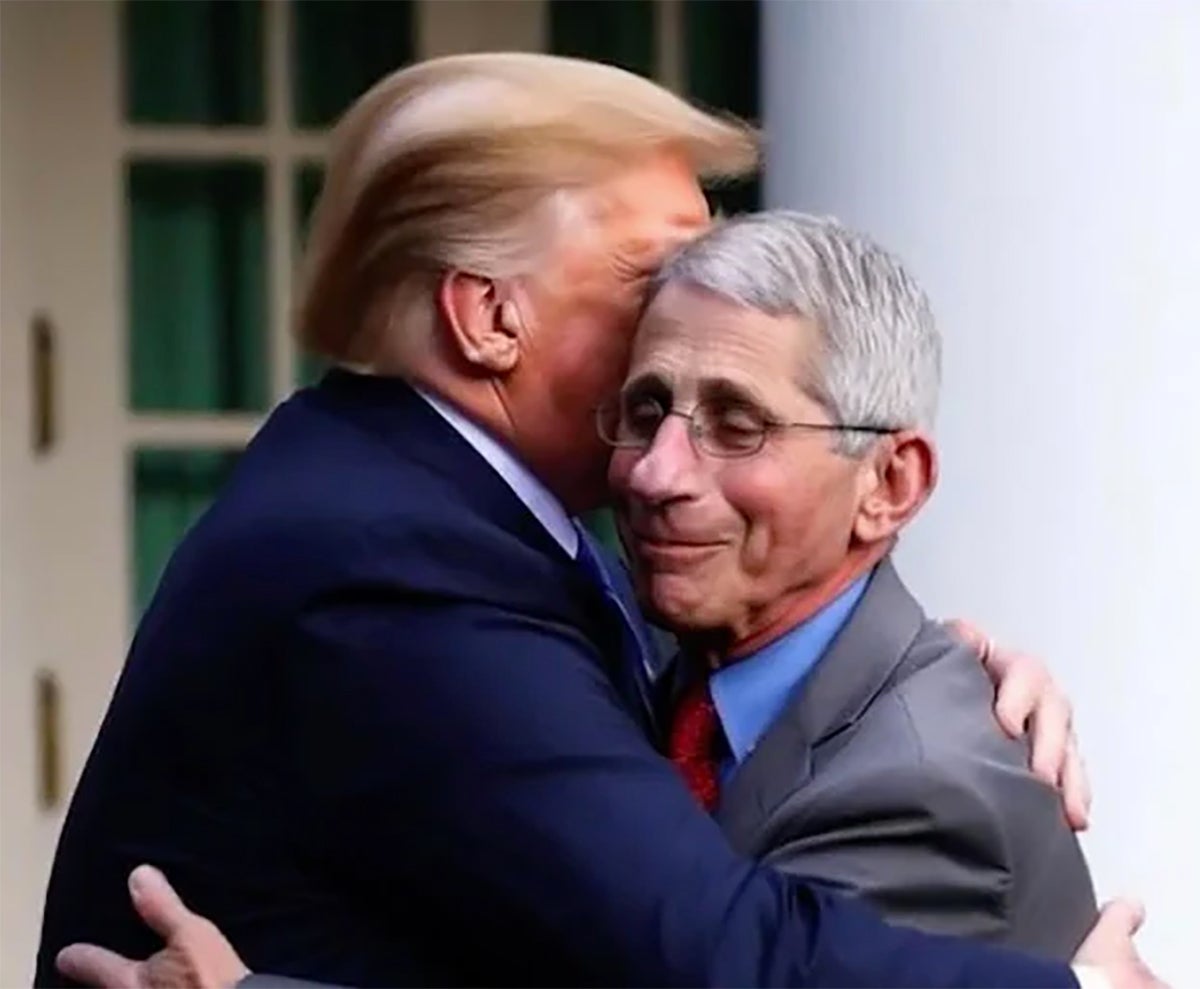EDITORIAL: Is it real, or is it AI hackery? It may soon be impossible to tell
Published 12:00 am Wednesday, June 14, 2023
The 2024 presidential campaign is already well underway and, even in this early stage, we are beginning to see the worst of politics on display and a troubling trend developing.
In a recent ad created by Florida Gov. Ron DeSantis for the Republican primary campaign, former President Donald Trump is the target, receiving flak from DeSantis for not firing Dr. Anthony Fauci, as chief medical advisor to the president during the COVID-19 pandemic.

A faked image of former President Donald Trump hugging Dr. Anthony Fauci, generated by AI and used in a new campisgn ad by Florida Gov. Ron DeSantis. Such concocted images are becoming prevalent in campaign ads on social media. (Screen shot)
Fauci has been made into something of a villainous figure in many conservative circles and, as such, the governor sought to portray Trump as his backer.
In the spot, Trump is criticized for not removing Fauci from his position and, as it progresses, it shows a collage of photos of the former president embracing him.
It would make a convincing case for those who dislike the doctor and would be a typical political ad, except for one thing: The embrace in the photo never happened.
The photos in question were never taken and are the result of artificial intelligence art programs, completely created out of thin air to depict something that simply did not take place.
Whatever one’s opinion on the politics of DeSantis, Trump or Fauci, it should be disturbing that a political campaign would put out images so easily that were not based in any kind of reality.
Republican JD Vance, the state’s junior U.S. senator,, who has made an early endorsement of Trump, was quick to criticize the spot.
“Seeing Donald Trump with fake AI images is completely unacceptable,” Vance posted on Twitter. “I’m not sharing them, but we’re in a new era. Be even more skeptical of what you see on the Internet.”
While Vance is correct on this point about the trend, he has been silent when such tactics are used on political figures he opposes.
Back in April, the Republican National Committee created an ad targeting President Joe Biden and Vice President Kamala Harris, depicting a series of nightmarish images that it stated would represent a second term of their administration.
Other than a teensy, tiny disclaimer, barely visible on screen in a small font, indicating the ad was created with AI, a viewer of the spot would have no idea that such scenes existed only in the imagination of the admaker.
Photoshopped, false images and deep fakes have existed for some time and have been circulated on the nether regions of the Internet in past elections, but, with the proliferation of AI, such deception can now be mass produced in an instant.
For instance, if a campaign wants to defame an opponent by falsely claiming they met with Osama Bin Laden, all it takes is typing a text prompt and clicking a button and they can have a bundle of ready-made smear photos showing the terrorist cuddling up to a political enemy.
Despite their claims to combat misinformation, social media companies have done little to nothing to curb the rampant spread of misinformation circulating on their sites.
Twitter’s new owner, billionaire Elon Musk, regularly proclaims himself a “free speech absolutist” (despite engaging in forms of censorship himself, when convenient) and seems to allow an “anything goes” approach to false information.
His much-touted “community notes,” user submissions to provide context, have been nonexistent on most false posts and have been proven to be an inadequate remedy to the problem.
And Musk also went out of his way to reinstate the accounts of multiple conspiracy theorists from the Qanon cult movement, who have long histories of circulating false information and smears.
While on Facebook, comments are routinely filled with false info and links to hoax sites, most of which are ignored or given a pass by the company.
With methods of spreading disinformation becoming more widespread, it is imperative that something be done to see to it that voters and the public will not find reality and the truth lost in an online sea of concocted illusions.
These companies need to address this issue and, if they refuse, perhaps it is time for the Federal Election Commission and regulators to take a closer look.
And this is certainly applicable to ads produced by parties and candidates. As it stands now, one can not simply make things up about an opponent in a television spot. The same should apply to imagery. At the least, such illustrations should be required by the FEC to show a clear disclaimer that they are artificially generated and not using actual photos or videos.
If left unrestrained, the amount of false reality will continue to grow until it matches the kind of thing once only written about in dystopian sci-fi works.
In the 1993 mini series “Wild Palms,” produced by Oliver Stone, the villainous character of Josie, portrayed by Angie Dickinson uses a fake virtual reality recording to blame others for a murder she committed.
“Does it matter?” she asks, smugly, when confronted about the falsity of the footage. “We’re already leading in the polls again.”
Sadly, this 31-year-old work looks a tad prophetic in 2024.
And, as the technology grows in sophistication, it will only get worse and more confusing.
In recent years, from Qanon to disturbingly large amounts of people professing a belief that the earth is flat, we have seen a detachment from reality take hold across social media by far too many, as kooks and con artists connect and amplify lies and ignorance.
An informed public is essential to a functioning democracy and schemes to create a deeply-deceived electorate through misinformation campaigns and irresponsible social media policies is truly troubling for our republic.






